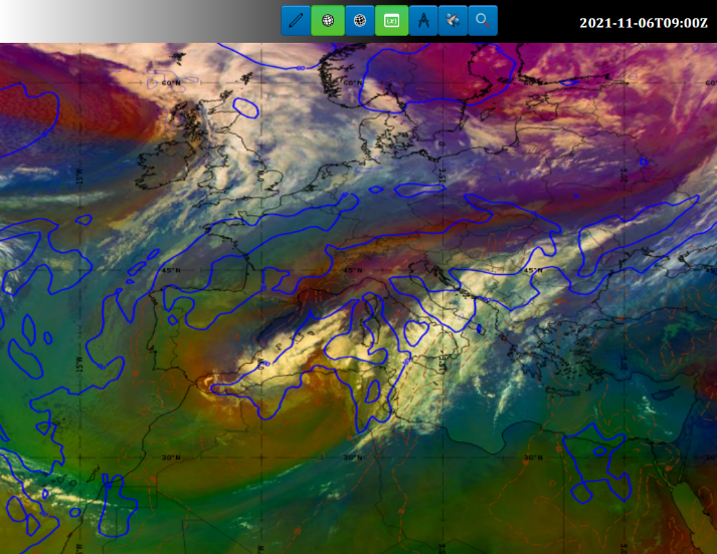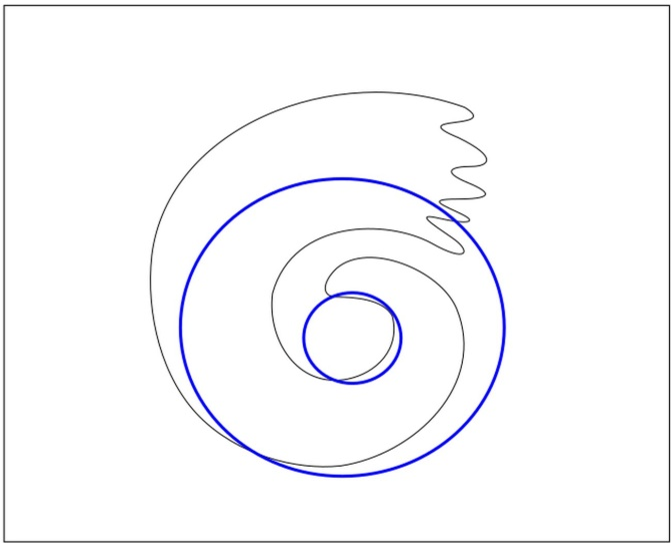Key Parameters
Since the medicane Ianos didn't show typical features in the formation stage, the medicane Blas (5. - 18. November 2021) will be used as an example for that stage.
Geopotential height 500 hPa
During the first stage of medicane formation, one typical feature in the upper atmosphere and one of the most important initiators is the presence of an upper level cut-off low approaching from the northwest, followed by intrusions of cold air. It is strongest in the formation stage and later gradually weakens as the medicane develops.
Figure 1: Schematics and satellite images of geopotential height (gpdam) at 500 hPa for developmental (Blas 6.11.2021. 12 UTC), mature (Ianos 16.9.2920. 18 UTC) and decay (Ianos 18.9.2920. 21 UTC) stage
300 hPa jet-stream
The upper level low is accompanied by a 300 hPa jet stream. The isotachs at 300 hPa in the formation stage show a pronounced jet stream along the rear edge of the convective cloudiness. A jet stream plays an important role in initiating medicane formation. In that early stage it is the most pronounced, while later on its importance fades.
Figure 2: Schematics and satellite images of 300 hPa jet-stream for developmental (Blas 6.11.2021. 12 UTC), mature (Ianos 16.9.2920. 18 UTC) and decay (Ianos 18.9.2920. 21 UTC) stage
PVA
Dry air brings with it high vorticity values from the upper levels to the system. In the formation stage, the highest values of the PV steamer are mainly located on the southern side of the convective cluster, which has been shown to be a typical configuration for generating medicanes. In the mature stage the PVA is typically strong and organized, in a 'tower' form, with a significant impact on the intensification and maintenance of the medicane. The advection of high-PV air from the upper troposphere into the low-level circulation enhances the development of the medicane by providing a source of potential energy. During the decay stage, the medicane weakens and dissipates as it moves over cooler waters or interacts with land, or due to enhanced vertical wind shear. PV advection is typically weak and disorganized at this stage, with no significant impact on the medicane's development.
Figure 3: Schematics and satellite images of PVA for developmental (Blas 6.11.2021. 12 UTC), mature (Ianos 16.9.2920. 18 UTC) and decay (Ianos 18.9.2920. 21 UTC) stage
Temperature advection
During the formation phase of a medicane or any cyclonic system in the upper atmosphere, cold advection is typically more prominent. The upper atmosphere, often associated with the mid-levels of the troposphere, is where we often see the initial development of temperature contrasts and instability that contribute to the formation of these systems. Cold advection in the upper atmosphere occurs when colder air aloft moves into an area previously occupied by warmer air. This can create instability and favor the development of organized convection, which is a key component of cyclonic system formation.
Figure 4: Schematics and satellite images of temperature advection for developmental (Blas 6.11.2021. 12 UTC), mature (Ianos 16.9.2920. 18 UTC) and decay (Ianos 18.9.2920. 21 UTC) stage.
Relative humidity
High values of RH are maintained throughout all stages of a medicane. During the formation stage, the RH is relatively high in the lower levels of the atmosphere, as warm and moist air from the Mediterranean is advected into the region. However, the RH decreases with height, as the air aloft is drier. This condition is favorable for the formation of convective storms that can trigger the development of the medicane.
During the mature stage, the RH is high in the lower levels of the atmosphere, as the medicane draws in warm and moist air from the surrounding regions. This condition is favorable for the intensification and maintenance of the medicane, as it provides a source of energy for the convective processes that drive the storm's circulation.
During the decay stage, the RH decreases as the medicane moves over cooler waters or interacts with land.
Figure 5: Schematics and satellite images of relative humidity on the level of 900 hPa for developmental (Blas 6.11.2021. 12 UTC), mature (Ianos 16.9.2920. 18 UTC) and decay (Ianos 18.9.2920. 21 UTC) stage.





























